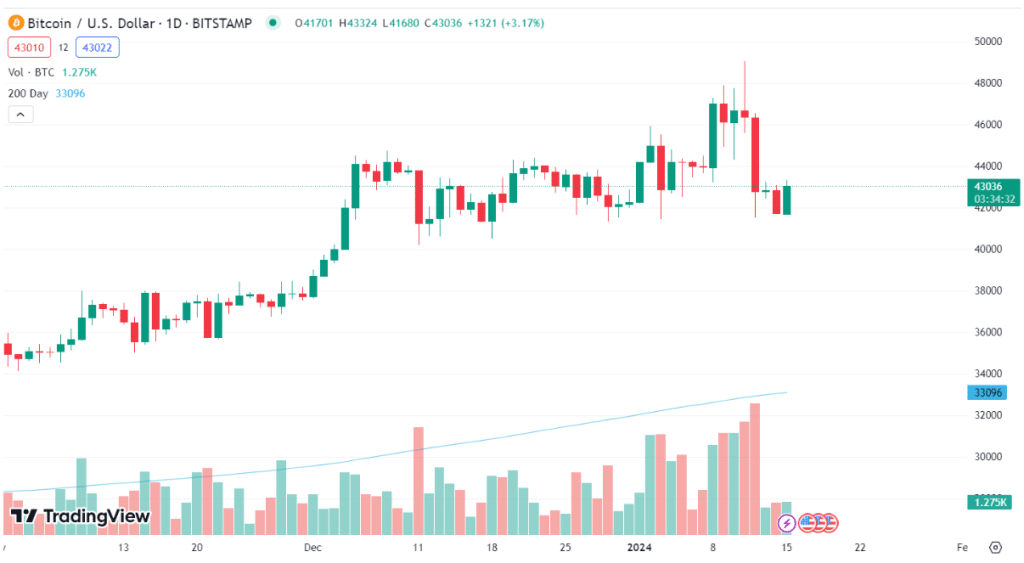The year 2023 witnessed a resurgence following the widespread crypto crash of late 2022, yet the market remains significantly below its previous peaks. Questions abound: Will crypto recover, or is it facing its demise? Alternatively, could the cryptocurrency realm be poised for its golden era?
Recent occurrences, such as the market sell-off triggered by a series of Bitcoin ETF approvals, have intensified existing market apprehensions. Furthermore, downturns propelled by deleveraging, though beneficial for the long-term health of the market, have left investors uneasy as prices fluctuate.
In this piece, we delve into the current cryptocurrency landscape, aiming to glean insights into what might unfold in the volatile realm of digital assets. Let’s piece together the puzzle and contemplate the potential outcomes that may emerge.
Crypto Market Dynamics
Bitcoin is trading between $41,700 and $42,900, indicating a lackluster crypto market. Bitcoin briefly reached $48,000 before and after Bitcoin ETF approval on January 10th.
Ether also fell somewhat in the same way and timing. The second-largest cryptocurrency by market value hit $2,700 before falling to $2,500 in the following days.
Altcoins like Cardano and Solana experienced short-term highs around Christmas 2023. Since then, Solana (SOL) has fallen 22%, from $123.76 to $96.40.
Cardano fell 18% from $0.66 to $0.54 in the weeks after Christmas.
Why is the crypto market down, and when will it recover? We identified many events as likely underlying causes of the market slump in our prior investigation.
After their approval, the 11 Bitcoin ETFs traded $4.6 billion on their first day and $3.1 billion on their second day, garnering attention. This action concentrated on GBTC, formerly the problematic Grayscale Bitcoin Trust, which had been trading below NAV for months before its ETF conversion. High fees may have caused withdrawals, negating BTC and ETF gains.
The anticipated momentum was lost after ETF authorization failed. Bitcoin prices were constant, rising slightly before decreasing when it became clear that a major jump was unlikely.
Unwinding leverage aggravated the market slump. Margin trades let investors wager more on crypto values, but leverage may increase losses during market downturns. Even a slight price drop may cause heavy liquidations when highly leveraged positions close, increasing selling pressure.
Which Cryptos are Crashing in March 2024?
Several top-100 cryptocurrencies fell in March 2024:
- Stacks (STX): The layer 2 protocol STX, which enables Bitcoin smart contracts, fell over 20% last week. This drop is more than twice Bitcoin’s (BTC) 9% drop. Despite one-month gains of roughly 60%, BTC’s drop certainly caused STX traders to take profits.
- Klaytn (KLAY): After almost doubling between September 2023 and the new year, KLAY fell over 20%. The price of KLAY returned 17.5% in 24 hours, showing its volatility.
- Bitcoin (BTC): As the market leader, BTC’s price usually affects others. Since the debut of ETFs, BTC has retraced 9% of its gains and is reaching short-term support. BTC was selling below $30,000 three months previously, then rose over 50% in a short period, prompting profit-taking.
- Bitcoin SV (BSV): True to Satoshi’s goal, Bitcoin SV gained more than BTC in the previous 30 days. Just like BTC, BSV has many declines. The price of BSV fell by 8% last week.
These findings demonstrate the volatility and interconnection of the cryptocurrency market, where price moves in big cryptocurrencies like BTC affect other altcoins, causing traders to take profits.
Cryptocurrencies that are likely to recover first
- Ethereum (ETH): Unlike BTC and other popular tokens like Solana (SOL), Injective (INJ), and Internet Computer (ICP), Ethereum has gained 11% in the previous week. Layer 2 tokens like Arbitrum (ARB) and Polygon (MATIC) were gained with ETH, demonstrating a separation between BTC and major EVM-compatible networks. The popularity of EVM-compatible DApps is a support for ETH’s recovery. Since 2022, ETH has risen from below $900 to over $2,500, proving its resiliency.
- Bitcoin (BTC): While experiencing recent declines, Bitcoin remains a prominent candidate for recovery due to its limited supply and growing demand. Despite differences from Ethereum, both cryptocurrencies share this fundamental characteristic, contributing to their long-term investment appeal. The potential for Bitcoin to rebound hinges on factors such as market sentiment, institutional adoption, and macroeconomic trends.
In conclusion, the strength of Ethereum’s ecosystem and the rising popularity of non-fungible tokens (NFTs) and decentralized finance (DeFi) are supporting a potential recovery. Bitcoin, on the other hand, maintains its allure as a store of value and hedge against inflation, suggesting a path for recovery amid ongoing market dynamics.
The Scarcity Narrative
Bitcoin and Ethereum’s scarcity story shows their resiliency in rising demand:
- Bitcoin’s Supply ceiling: With a fixed supply ceiling of 21 million coins, Bitcoin faces increased competition for coins, particularly because 11 ETFs provide regular investors easy access to BTC. The April 2024 halving, which halves the quantity of new bitcoins by 50%, has traditionally caused double- or triple-digit increases in the months after.
- However, Ethereum’s supply dynamics vary. Bitcoin has a supply limit, while Ether does not. Ethereum creates new tokens for staking rewards and burns some of the acquired ETH as transaction fees, causing deflation. Top layer 2 networks like Arbitrum and the new Base use ETH as gas for smart contracts. Meanwhile, ETH stakes are rising.
How Do We Know if Crypto Will Recover?
Supply and demand dynamics are key to predicting the cryptocurrency market’s recovery. Why Bitcoin (BTC), Ethereum (ETH), and other new crypto projects may continue to surge in demand:
- Bitcoin ETFs have made cryptocurrencies accessible to regular investors, increasing their popularity. This increased awareness should attract new crypto investors. Additionally, investors may hold BTC or ETH via ETFs and manage other crypto assets individually.
- Technology Advancements: The cryptocurrency sector is relatively young, with technology advances driving innovation. Kaspa, which improves transaction speed while maintaining Bitcoin security, shows crypto’s increasing possibilities. These developments show the industry’s early growth.
- Crypto investors have long worried about regulatory uncertainty. Recent US approvals of 11 BTC spot ETFs provide regulatory certainty. Clearer regulatory frameworks may boost market participation and trust, but it takes time.
- Simplifying the user experience while preserving security is key to crypto acceptance. Tangem wallets leverage user-friendly UI and offline security to do this. Continued innovation in user-friendly solutions could boost mainstream acceptance.
- Crossover Utility: Chainlink, Avalanche, and Cosmos combine blockchain with finance. These ideas allow crypto to disrupt conventional banking by tokenizing real-world assets. Cryptocurrencies’ usefulness and value will improve when blockchain technology integrates with financial institutions.
Tips for Avoiding Crypto Crash Panic
Consider these strategies to handle crypto breakdowns without panicking:
- In the unpredictable crypto market, never invest more than you can afford to lose. Only invest what you can afford to lose due to its volatility and collapse.
- Avoid Impulsive Moves: Stay cool amid market turmoil and avoid short-term price-based judgments. Check your original investment premise to see whether it still makes sense. In volatile markets, sticking to the course is often best.
- Diversify Your Portfolio: Invest in equities, bonds, real estate, commodities, and cryptocurrency. By minimizing investment dependence, diversification reduces risk. Consider adding Ethereum (ETH) and Bitcoin (BTC) to your portfolio, along with other potential startups.
- Before investing in a cryptocurrency project, do your own investigation. Avoid social media hype and pump-and-dump tactics. Whitepapers, project leadership, token supply, and community interaction are reliable sources. Self-research may help you avoid fraud and make smart investments.
- Dollar-Cost Averaging (DCA): Instead of investing everything at once, consider averaging. DCA invests a preset amount at regular intervals, independent of the asset price. This decreases price volatility and the danger of purchasing during market peaks. DCA may construct a market-resistant investment portfolio over time.
Investors can weather crypto market collapses by following these guidelines and thinking long-term.
Will Crypto Recover? Our Final Thoughts
Our ultimate opinion is that although individual cryptocurrencies may be risky, the crypto industry is resilient and innovative. Despite the danger of asset losses, the sector has grown and adopted more during its 15-year existence.
Cryptocurrency has many development and progress prospects. Once a fringe asset, the crypto industry is now mature with less dangers and greater promise.
Not sure when the crypto market will rebound to its highs. The recovery may take years to reach 2021 levels, but it may happen quicker than expected. Bitcoin (BTC) and Ethereum (ETH) are projected to remain dominant, although other initiatives might succeed.
References
- Reuters.com: US bitcoin ETFs see $4.6 billion in volume in first day of trading
- Coindesk.com: Shares in Grayscale’s Bitcoin Trust Trade at 36% Discount to Fund’s NAV
- Coingecko.com: Ethereum Price
- CNBC.com: Bitcoin is one year away from a major technical event
- Cointelegraph.com: Bitcoin Halving: How it works and Why it matters
- Coingecko.com: Ethereum Staking Statistics 2023
Will Crypto Recover in 2024 and Other FAQs
Will Crypto Recover in 2024?
In 2024, continued recovery towards the all-time highs of 2021 is expected. Factors such as increased adoption and inflows into Bitcoin ETFs, alongside potential launches of Ethereum ETFs, could drive added demand for Bitcoin and Ethereum. With their limited supplies, this increased demand may lead to a broader market recovery.
Which Crypto Will Recover the Fastest?
Ethereum (ETH) has demonstrated significant strength recently, even during periods when other assets like Bitcoin faced challenges. While smaller projects may offer dynamic returns, they also carry higher risks. A portfolio comprising a core investment in Bitcoin and Ethereum provides relative safety while benefiting from retail demand in both ETFs and spot markets.
How Long Will it Take Crypto to Recover?
While 2024 is anticipated to be a crucial year for recovery, the process has already commenced. Bitcoin has tripled in value since its lows, while Ethereum’s price has quadrupled since 2022. Although a return to all-time highs and beyond may take years, the crypto market is known for its rapid movements, suggesting the potential for a faster recovery.
How do We Know if Crypto Will Recover?
While there are no guarantees, several metrics offer reasons for optimism. Monitoring adoption rates and inflows, particularly in ETFs and smart-contract networks like Ethereum, where Total Value Locked (TVL) indicates real usage, can provide insights into the potential for recovery.
Is Crypto Over?
Crypto’s volatility, including its significant rise and subsequent crash, underscores its unpredictable nature. However, a crash does not signify the end, as the market has already regained much of its losses. With Bitcoin and Ethereum representing a significant portion of the market and possessing limited supplies, increasing demand could lead to higher prices for both assets.





